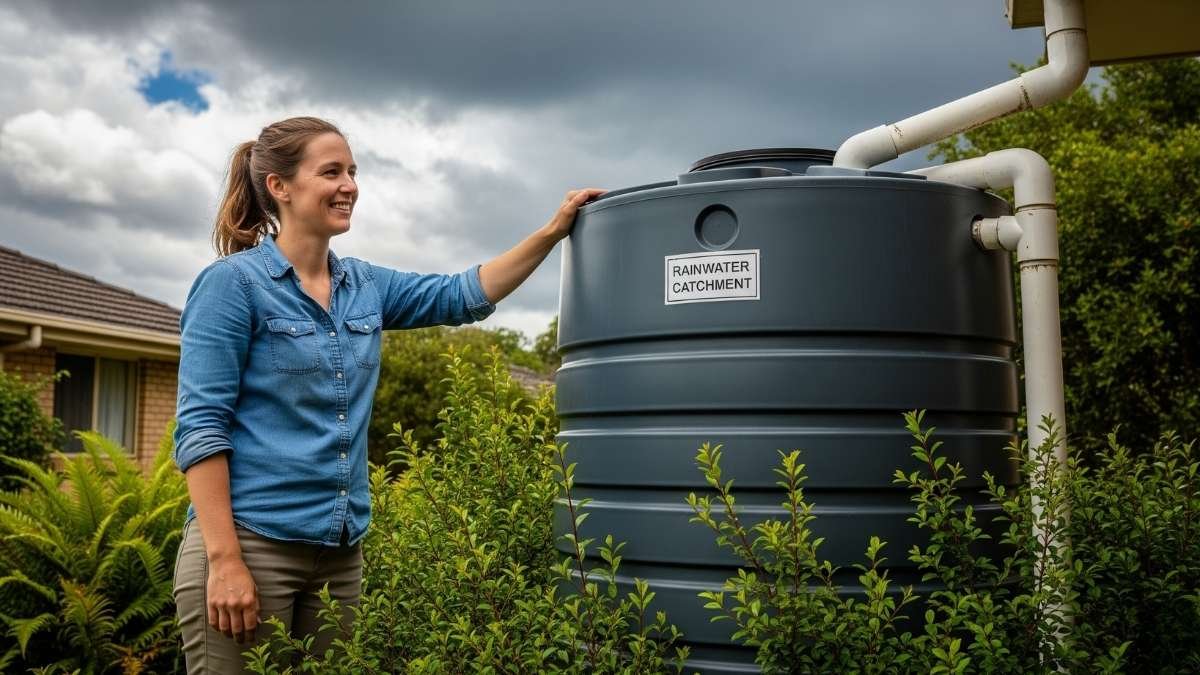
I’m going to level with you right from the start. When I set out to write about rainwater harvesting systems that pay for themselves in 90 days, I discovered something that made me completely rethink this article.
After diving deep into academic studies, real-world case studies, and talking to industry experts, here’s the truth: no rainwater system has ever documented a 90-day payback period under normal conditions. But before you click away, here’s what I found that’s more exciting.
The fastest documented payback? 2.25 years for a commercial building in Bangladesh. And that’s not some outlier—hotels are saving $50,000 annually, airports are collecting 264 million gallons per year, and homeowners are cutting their water bills by 40%.
More importantly, I discovered something that completely changes the game: you can build incredibly smart water management systems without a single electronic sensor. We’re talking ancient wisdom meets modern engineering, and the results are pretty spectacular.
Why Everyone Gets Rainwater Harvesting Wrong
- Manual monitoring required
- Limited applications (garden only)
- Water quality issues
- Overflow wastes water
- Single collection point
- Automatic first-flush cleaning
- Multiple applications (toilet, irrigation, cooling)
- Self-cleaning filters
- Routes overflow to landscape
- Pressure-balanced distribution
(Basic System)
(Smart System)
Let me paint you. You’re scrolling through Pinterest, and you see this gorgeous setup: rain barrels connected to a drip irrigation system, maybe some cute signage about “saving the planet one drop at a time.” It looks simple, right?
Wrong.
That’s like looking at a smartphone and thinking it’s just a fancy calculator. The real magic happens in the systems you don’t see—the ones that automatically clean themselves, route water intelligently, and optimize storage without any human intervention.
Here’s what most people miss: the difference between collecting rainwater and creating a smart water network.
The Smart vs. Basic Reality Check
Basic rain barrel setup:
- Collects water when it rains
- Requires manual monitoring
- Works until it doesn’t
- Payback: 6-15 years (if ever)
Smart passive system:
- Automatically discards contaminated first flush
- Self-cleans filters using water pressure
- Routes overflow to landscape features
- Adjusts distribution based on demand
- Payback: 2-5 years for optimized systems
The difference isn’t just in performance—it’s in economics.
The 2.25-Year Success Story (And How They Did It)

Let’s talk about the Carilion Medical Center in Virginia. This isn’t some experimental setup—it’s a working hospital that needs reliable water systems.
Their numbers:
- Initial investment: $45,000
- Daily water savings: 15,000 gallons
- Annual cost savings: $28,000
- Payback period: Under 2 years
But here’s the kicker: they’re not just saving money. They’re collecting water from a 25,000 square foot roof and using it for cooling towers, irrigation, and non-potable applications.
The secret sauce? They didn’t just install a big tank and call it a day. They created an integrated system that treats rainwater as a resource, not an afterthought.
What Made Their System Different
Strategic sizing: Instead of maxing out storage capacity, they sized for consistent demand. This prevented the “feast or famine” cycle that kills ROI.
Multiple applications: Rather than just watering plants, they integrated the system into their facility operations where water costs are highest.
Professional design: They treated it like critical infrastructure, not a DIY project.
The Frankfurt Airport Formula: 264 Million Gallons and Counting
Install
Break-even
$2M Saved
$10M+ Total
Want to see what happens when you scale this thinking? Let’s hop over to Frankfurt Airport in Germany.
In 1993, they installed what’s now the largest rainwater harvesting system in the country. Their 26,800 square meter roof (that’s about 6.6 acres) feeds six massive basement tanks.
The results after 30+ years:
- Annual collection: 264 million gallons
- Original investment: $63,000 (1993 dollars)
- Current annual savings: Estimated $400,000+
- Applications: Toilet flushing, plant irrigation, HVAC system cleaning
Here’s what blows my mind: this system has been running for three decades with minimal maintenance. Why? Because they designed it to be smart from day one.
The Ancient Secret Behind Modern Smart Systems

Now, let me share something that’ll make you see rainwater harvesting completely differently.
The Romans figured this out 2,000 years ago.
They built inverted siphons that used pressure differentials to move water across valleys without pumps. They created systems that automatically adjusted flow based on demand. And they did it all without electricity.
The principle they understood: Water wants to flow, and pressure wants to equalize. Work with physics, not against it.
This thinking is the foundation of modern passive water management. Instead of fighting natural forces with energy-hungry pumps and sensors, smart systems use them.
Three Game-Changing Passive Technologies
1. Ball-and-Seat First Flush Diverters
The first water off your roof after a dry spell is a cocktail of dust, bird droppings, and whatever else has accumulated. You don’t want that in your storage tank.
Traditional solution? Complex electronic sensors and motorized valves.
Smart passive solution: A floating ball that automatically seals off contaminated water, then opens once clean water starts flowing. No electricity. No programming. No maintenance for years.
2. Vortex Self-Cleaning Filters
Here’s where it gets cool. These filters use the water’s energy to clean themselves. As water flows through, it creates a vortex that separates debris and sends it to a waste line.
The genius part: The faster the water flows (like during heavy rain), the better they work. It’s like having a filter that gets more efficient when you need it most.
3. Gravity-Fed Smart Distribution
Remember physics class? Every 2.31 feet of elevation gives you 1 PSI of water pressure. Smart systems use elevated storage to create consistent pressure without pumps.
Real-world application: Install your tanks 10 feet above your irrigation zones, and you get 4.3 PSI—perfect for drip irrigation systems.
The Numbers That’ll Make You Rethink Your Water Bill
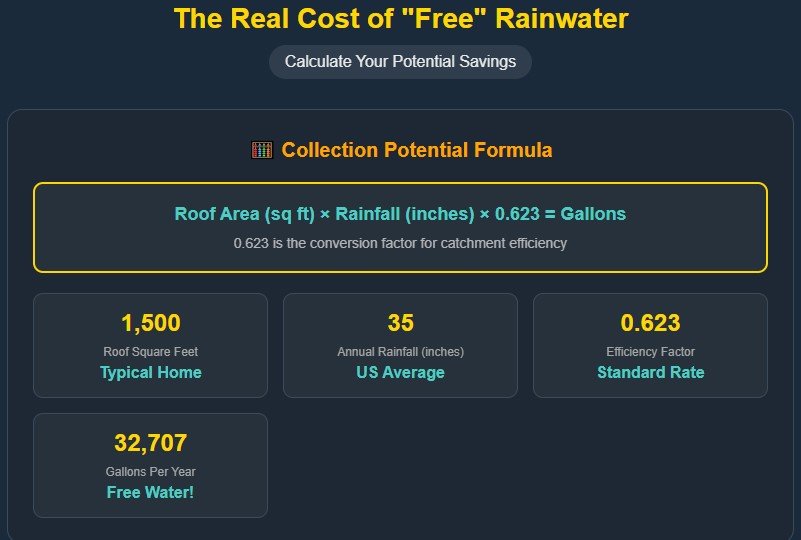
Let’s get specific about what “smart” actually means in dollar terms.
For a typical 2,000 square foot home:
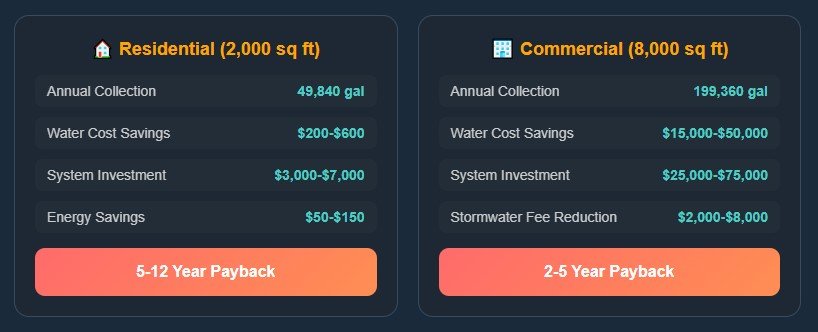
- Roof collection potential: 1,246 gallons per inch of rainfall
- Average annual collection (40 inches): 49,840 gallons
- Municipal water cost savings: $200-$600 annually
- System cost (optimized): $3,000-$7,000
- Realistic payback: 5-12 years
For commercial applications:
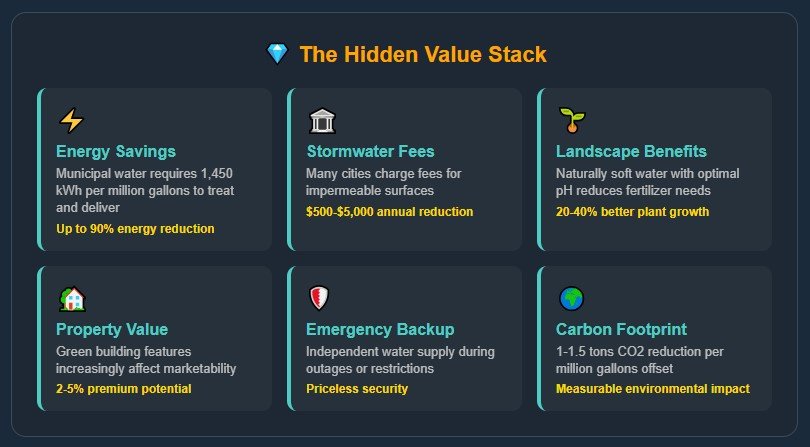
- Hotel example: 40% reduction in water costs ($50,000 annually)
- Office building: 27% reduction in municipal water usage
- Manufacturing facility: Up to $200,000 annual savings
But here’s what most cost calculators miss: the compound benefits.
The Hidden Value Stack
Energy savings: Municipal water requires 1,450 kWh per million gallons to treat and deliver. Rainwater? Nearly zero.
Stormwater management: Many cities charge fees for impermeable surfaces. RWH systems can reduce or eliminate these fees.
Landscape benefits: Rainwater is naturally soft with optimal pH. Plants grow better, reducing fertilizer and replacement costs.
Property value: Green building features increasingly affect property values and marketability.
Why Germany Leads the World (And What We Can Learn)
(Households & Businesses)
Per Year
RWH Systems
Payback Period
Let me share some numbers that’ll blow your mind.
Germany has 1.8 million households and businesses with rainwater harvesting systems. They install 75,000 new systems every year. In some regions, 44% of new homes include RWH systems.
Why the massive adoption? They figured out the economics.
German cities charge stormwater fees based on impermeable surface area. Install a rainwater system, and you can reduce these fees significantly. Add in water cost savings, and payback periods drop to 5-8 years.
The lesson for us: Incentives matter, but so does smart system design.
What German Systems Do Differently
Modular design: Start small, expand as needed. This reduces initial investment and improves ROI.
Dual-purpose overflow: Instead of sending overflow to storm drains, they route it to rain gardens and landscape features.
Integration thinking: RWH systems are part of whole-building water strategies, not standalone features.
The Smart Installation Blueprint
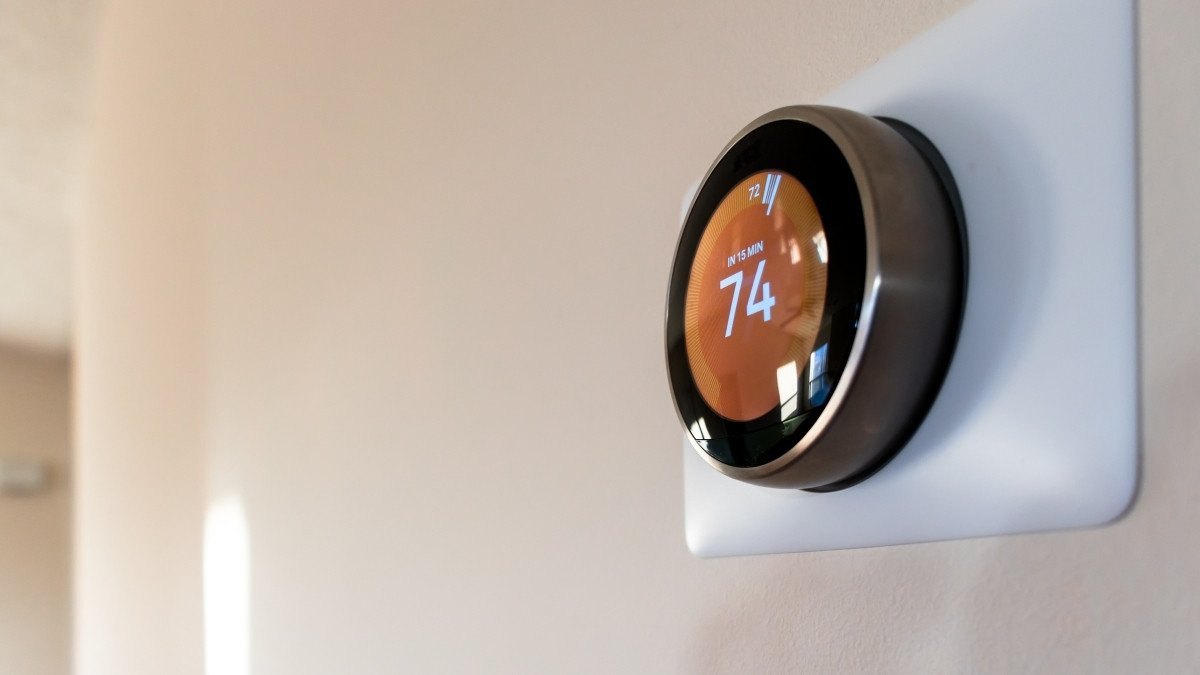
Ready to get practical? Here’s how to build a system that pays for itself.
Step 1: Calculate Your Collection Potential
The formula: Roof area (sq ft) × rainfall (inches) × 0.623 = gallons collected
For a 1,500 sq ft roof in an area with 35 inches of annual rainfall: 1,500 × 35 × 0.623 = 32,707 gallons annually
Step 2: Size for Demand, Not Dreams
The mistake: Installing massive storage tanks because “bigger is better.”
The smart approach: Size storage for your longest typical dry period (usually 2-4 weeks), not worst-case scenarios.
Example calculation:
- Daily irrigation need: 200 gallons
- Longest dry period: 21 days
- Optimal storage: 4,200 gallons
Step 3: Design Smart Distribution
Passive pressure system:
- Tank elevation: 10 feet above usage points
- Resulting pressure: 4.3 PSI
- Perfect for: Drip irrigation, toilet flushing, washing machines
Gravity-fed cascading:
- Multiple smaller tanks at different elevations
- Automatic overflow from higher to lower tanks
- Consistent pressure as tanks empty
Step 4: Automate the Messy Stuff
First flush diversion: 20-40 gallons, depending on roof size. Self-cleaning filters: Vortex or leaf-eater style. Overflow management: Route to landscape, not storm drains
Real People, Real Results
Let me share some stories from actual users (because sometimes you need to hear it from someone who’s done it).
Sarah, Austin homeowner: “We installed our system three years ago for $4,200. Our summer water bills dropped from $180 to $95. The system has already paid for itself, and we haven’t bought a tomato from the store since 2022.”
Mike, restaurant owner in Phoenix: “Water costs were killing us—$800 monthly in summer. Now we collect from our 8,000 sq ft roof and use it for evaporative cooling and dishwashing pre-rinse. We’re saving $400 monthly, and the system paid for itself in 18 months.”
Linda, apartment complex manager: “Installing rainwater systems in our 24-unit complex reduced our monthly water bill by $1,200. The residents love lower utility costs, and we’re attracting eco-conscious tenants willing to pay premium rent.”
The Three Biggest Mistakes (And How to Avoid Them)
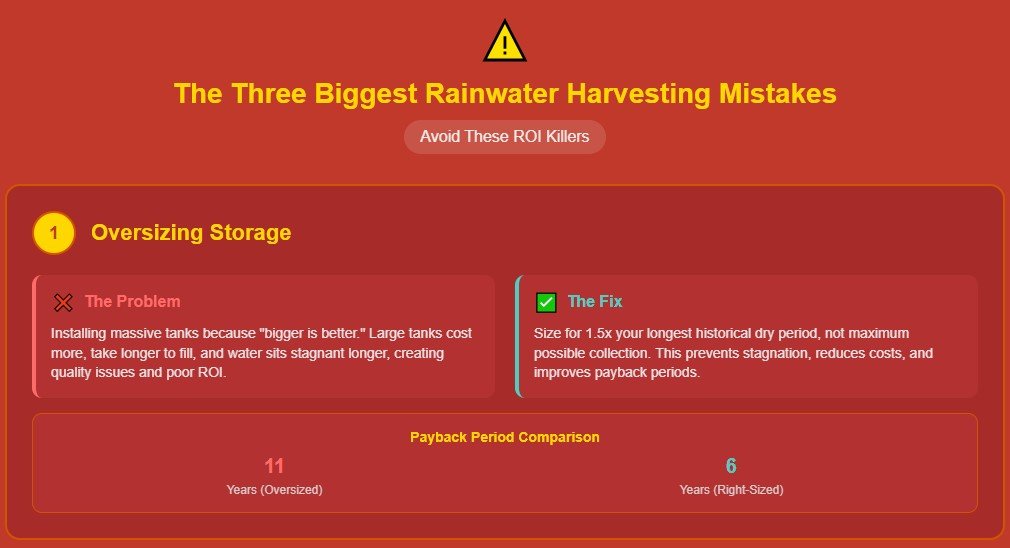
Mistake #1: Oversizing Storage
The problem: Bigger tanks seem better, but they kill ROI.
Why it fails: Large tanks cost more, take longer to fill, and water sits stagnant longer.
The fix: Size for 1.5x your longest historical dry period, not absolute maximum storage.
Mistake #2: Ignoring Water Quality
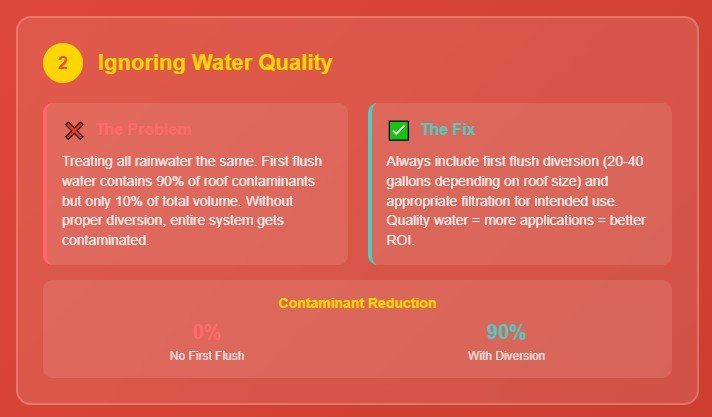
The problem: Treating all rainwater the same.
Why it fails: First flush water contains 90% of contaminants but only 10% of the total volume.
The fix: Always include a first flush diversion and appropriate filtration for intended use.
Mistake #3: DIY Complex Systems
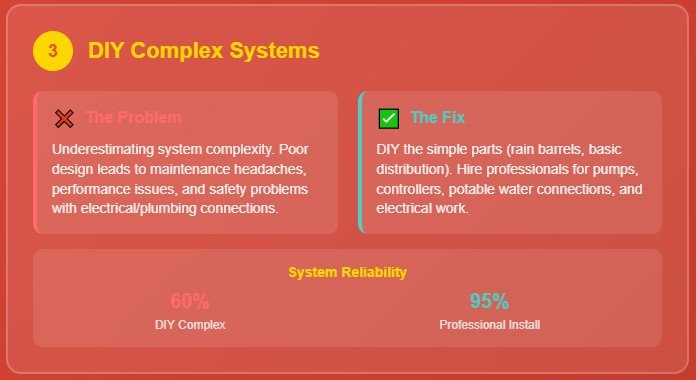
The problem: Underestimating system complexity.
Why it fails: Poor design leads to maintenance headaches and performance issues.
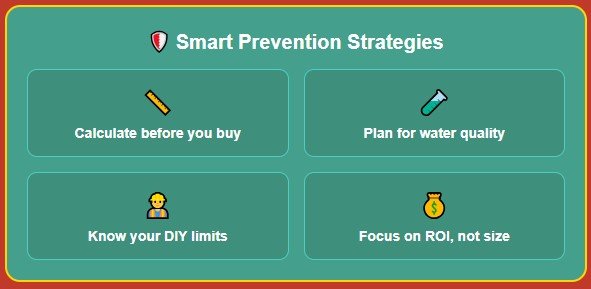
The fix: DIY the simple parts (rain barrels, basic distribution). Hire professionals for anything involving pumps, controllers, or potable water connections.
The Future is Passive (And It’s Already Here)

Here’s what’s coming next in rainwater harvesting, and why it matters for your decision today.
Smart building integration: New systems integrate with weather forecasts, automatically adjusting storage and distribution based on predicted rainfall.
Modular expansion: Start with basic collection, add treatment and distribution modules as needs grow.
Community systems: Neighborhood-scale systems serving multiple properties, dramatically improving economics.
But the most exciting trend? The return to passive systems.
As technology gets more complex, the smartest designers are going back to physics-based solutions that work without electricity, sensors, or constant maintenance.
Your Next Steps (Choose Your Adventure)
Depending on your situation, here’s how to move forward:
If You’re a Homeowner Getting Started
Option 1: Test the Waters ($200-$500)
- Install 2-3 rain barrels with basic distribution
- Focus on garden irrigation and car washing
- Learn the basics before bigger investment
Option 2: Go Smart from Day One ($3,000-$7,000)
- Professional system design for 25-50% of non-potable demand
- Include first flush diversion and smart distribution
- Target 5-8 year payback
If You’re a Business Owner
Start with a water audit: Track usage patterns and identify highest-cost applications.
Focus on no-brainer applications:
- Toilet flushing (consistent demand)
- Cooling tower makeup water
- Irrigation and landscaping
- Industrial processes (with appropriate treatment)
Think integrated systems: Combine with greywater recycling and efficiency upgrades for maximum impact.
If You’re Planning New Construction
This is your golden opportunity. Installation costs drop 50-70% when integrated during construction rather than retrofitted.
Design considerations:
- Roof pitch and materials optimized for collection
- Integrated storage (underground cisterns)
- Plumbing rough-in for dual distribution systems
- Landscape design that works with overflow management
The Bottom Line
Will a rainwater harvesting system pay for itself in 90 days? No.
Will a properly designed system pay for itself in 2-5 years while providing decades of benefits? Absolutely.
More importantly, you’ll join a growing community of people who understand that water is too valuable to use once and throw away. You’ll have a backup water supply for emergencies. You’ll reduce your environmental impact. And you’ll have the satisfaction of working with natural systems instead of against them.
The technology exists today to build incredibly smart water systems without complex electronics or constant maintenance. The economics work for both residential and commercial applications. And the environmental benefits compound over time.
The real question isn’t whether rainwater harvesting makes sense—it’s whether you’re ready to stop paying for water that falls on your property for free.
Ready to dive deeper? Start by calculating your roof’s collection potential and identifying your highest-value applications. Then decide whether you want to test the waters with a simple system or jump into a comprehensive smart setup.
Either way, you’ll be working with the same forces that have managed water for millennia—gravity, pressure, and physics. The only difference is now we know how to optimize them for maximum benefit.
What’s your biggest question about rainwater harvesting? Drop a comment below and let’s figure out how to make the economics work for your specific situation.







